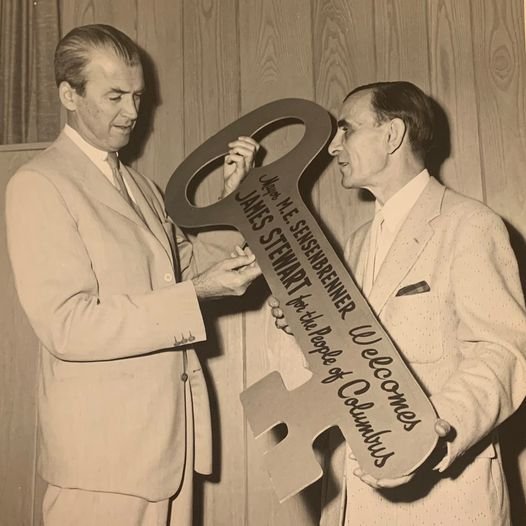Questions about this collection? Want to donate to this collection? Don’t hesitate to contact us!
PHONE: 614-224-0822 | EMAIL: INFO@COLUMBUSHISTORY.ORG
This collection consists of papers, images and artifacts from the terms of Mayors Maynard E. “Jack” Sensenbrenner, Gregory S. Lashutka and Michael B. Coleman. These collections provide an unprecedented insight into the offices of the mayors between 1954-1960 and 1964-1972. The processing and preservation of this collection was aided with the help of an archives grant from the Ohio Historical Records Advisory Board, funded by the National Historical Publications and Records Commission of the National Archives.
Finding aids
This collection is currently offsite.
MAYOR MICHAEL B. COLEMAN COLLECTION
Made possible through a grant from the Ohio Historical Records Advisory Board
Overview of the Collection
Number: 2016.003
Title: Mayor Michael B. Coleman Collection
Creator: Bonnie Chandler
Dates: 1999-2015
Media: Mixed
Quantity: 10 cubic feet
Location: Columbus Historical Society Office
Historical Sketch of the Collection
Mayor Michael B. Coleman, a democrat, served as the 52nd mayor of the City of Columbus from January 1, 2000 to December 31, 2015. He was the longest serving mayor, serving for 4 consecutive terms, and he was also the first African American mayor of Columbus. Mayor Coleman was known to be fiscally responsible and early in his tenure was able to raise the city income tax to 2.5% which enabled the city to increase police and fire services. In 2003 Coleman announced a 10 year plan that would revitalize downtown with new housing, the Columbus Commons and parkland along the river known as the Scioto Mile. In 2008 a large bond issue passed allowing the city to cleanup neighborhoods and teardown many vacant houses. Curbside recycling also began during his tenure. One of the biggest controversies during the Coleman years was the failure of the school Levy in November 2013 in lieu of the Columbus City School’s data rigging scandal. Mayor Coleman will be remembered for bringing “swagger” to Columbus as it left its small town image behind.
Scope and Contents of the Collection
This collection contains materials related to the election and 4 mayoral terms of Columbus mayor Michael B. Coleman. VHS cassettes and photographic prints and negatives form the bulk of the collection. The collection also contains CDs/DVDs, audio cassettes, DVCPRO videos, Betacam videos, letters and cards, plaques and framed images, certificates, books, printed speech drafts, photocopies of news clippings, memorabilia and gifts, and ephemera.
MAYOR GREGORY S. LASHUTKA COLLECTION
Made possible through a grant from the Ohio Historical Records Advisory Board
Overview of the Collection
Number: 2014.038
Title: Mayor Gregory S Lashutka
Creator:
Dates: 1965-2011
Media: Mixed
Quantity: Ca. 28 cubic feet
Location: Columbus Historical Society Office
Historical Sketch of the Collection
Mayor Gregory S. Lashutka, a republican, served 2 terms as the 51st mayor of Columbus from January 1, 1992 to January 1, 2000. Mayor Lashutka played football at The Ohio State University under famed coach Woody Hayes. He served 2 terms as Columbus City Attorney from 1978-1985. As Mayor, he was noted for being fiscally responsible. During his tenure the city saw economic growth, downtown development and low unemployment. Lashutka launched the development of the Scioto riverfront with the move of COSI (Center of Science and Industry) to the Scioto Peninsula and began construction of the floodwall in Franklinton. He helped facilitate the building of Nationwide Area which brought national hockey to Columbus and the development of the Area District. The suburbs also experienced growth. Easton and Polaris shopping areas were developed and a new sewer and water deal with the city of Dublin was brokered. His biggest challenge was a contentious and costly legal battle with the police chief, James G. Jackson, for administrative misconduct. Mayor Lashutka left office known for being a consensus-builder and a highly effective public servant.
Scope and Contents of the Collection
This collection contains materials from Mayor Lashutka’s campaigns for city attorney and mayor, his tenures in both offices, and beyond. Materials are both professional and personal and include photographs, campaign videos and ephemera, papers and newsclippings, books, and other media.
MAYOR MAYNARD E. "JACK" SENSENBRENNER COLLECTION
Made possible through a grant from the Ohio Historical Records Advisory Board
Overview of the Collection
Number: 2015.FIC
Title: Mayor Maynard E. “Jack” Sensenbrenner Collection
Creator: Tara Babb
Dates: Ca. 1954 – ca. 1981
Media: Photographic prints, Mixed Media
Quantity: 2.0 cubic feet
Location: Columbus Historical Society Office
Historical Sketch of the Collection
Mayor Maynard Edward Sensenbrenner, a democrat, served two non-consecutive terms as the 42nd and 44th mayor of Columbus from 1954-59, and 1964-71. The 1959 flood cost him the election between his two terms.
At the time, he was the longest serving mayor, serving for 14 years. He was born in Circleville, Ohio, September 18, 1902 and died from complications of Alzheimer’s on August 2, 1991.
Sensenbrenner went by the name “Jack”, and was known for his energy and ambition, even creating the word “spizzerinctum” to describe his style and philosophy of life. He and his wife, Mildred, lived and raised their two sons on the Hilltop. He was a big supporter of the Boy Scouts and other fraternal organization. He was also very religious and was known for running the largest Sunday school class in the city. A product of the depression of the 1930s, he came to political office late in life at age 50. His biggest accomplishment as mayor was the annexation and growth of the city. Through annexation, Columbus grew by 70 square miles. During his tenure, Columbus was named the “All American City” in 1959.
Scope and Contents of the Collection
This collection contains materials related to political life of Mayor Jack Sensenbrenner. Most of the collection comprises 638 photographs taken during Mayor Sensenbrenner’s two terms in office. Most of these are 8 x 10 black and white photographs. Many of the images are of the Mayor performing official business such as signing proclamations, attending ground breakings, ribbon cuttings, and business and political functions.
The collection also contains one folder of miscellaneous papers and two award plaques and a print of a charcoal portrait of Mayor Sensenbrenner. Additional three-dimensional objects relating to Mayor Sensenbrenner’s time in office will be added to this collection as they are processed.



